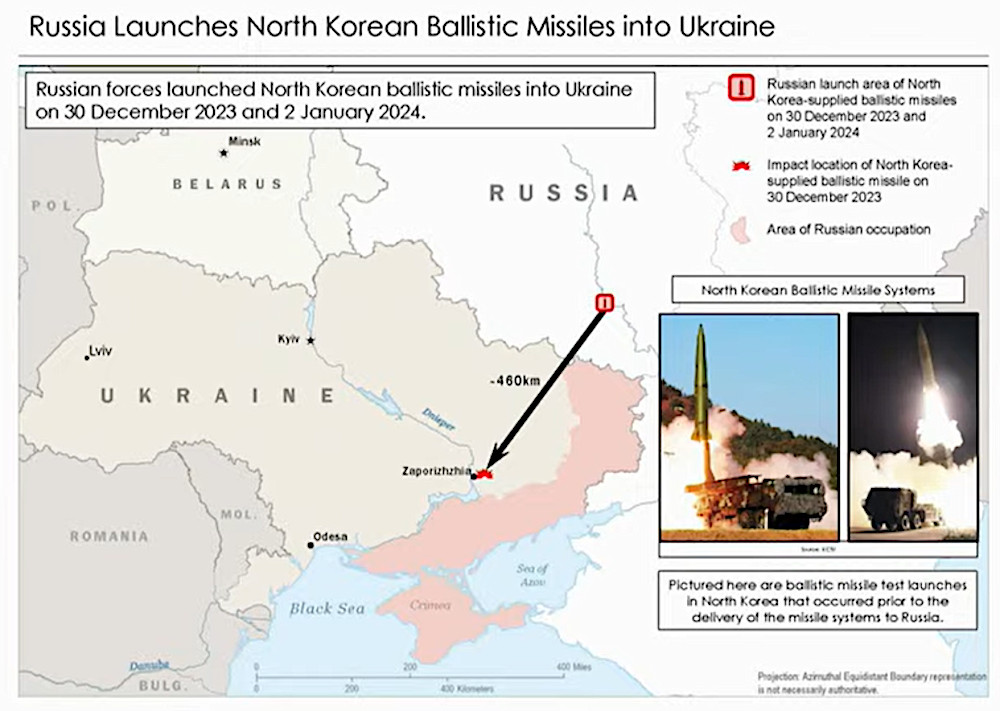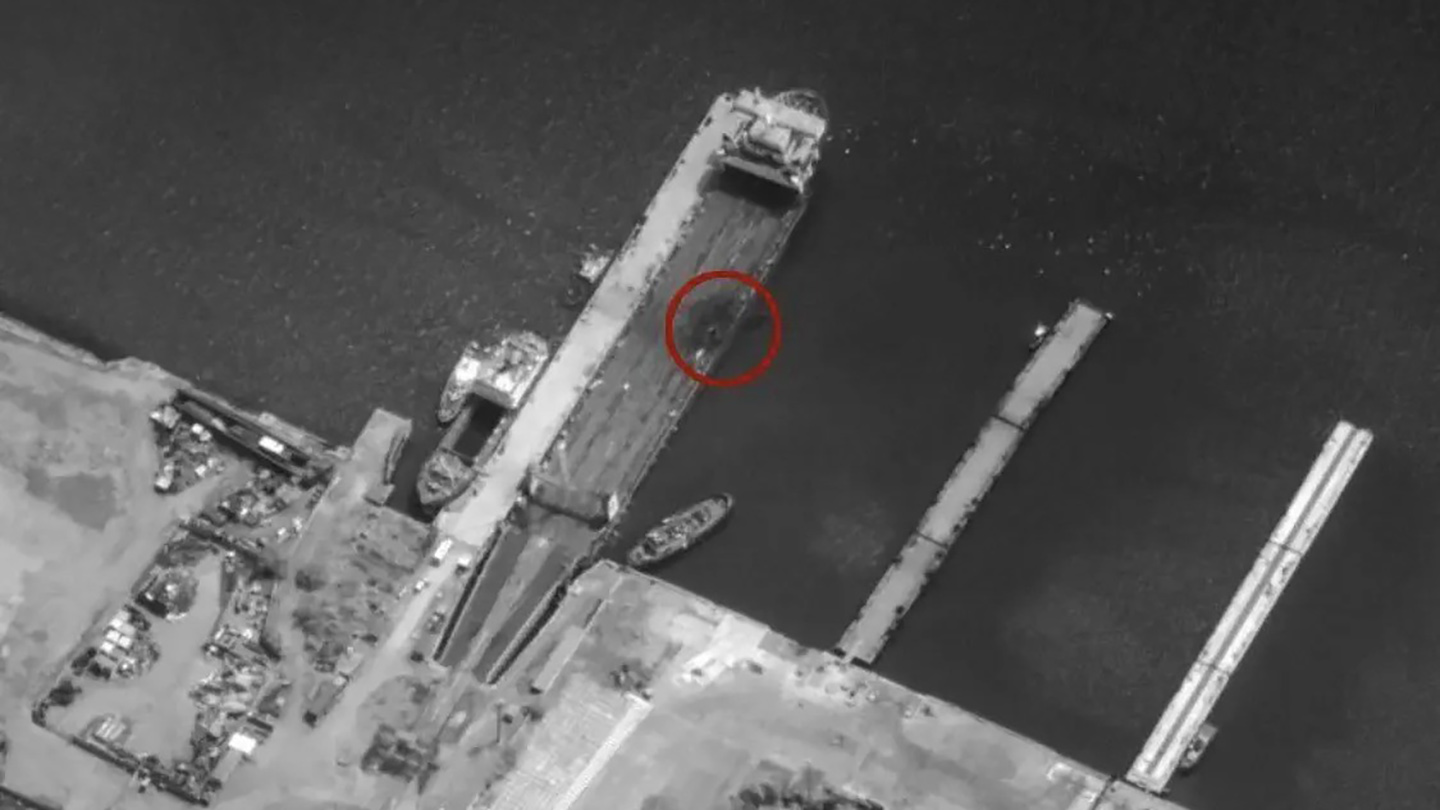The Ukrainian General Staff released satellite imagery of what it says was a U.S.-supplied Army Tactical Missile System (ATACMS) strike on Russian ferries in Kerch. That city is home to the bridge connecting Crimea to the Russian mainland and which has been targeted on several occasions before. The ferries have been critical for transporting Russian troops and materiel heading to the front lines, especially during interruptions with traffic on the bridge.
“Tonight, the Defense Forces of Ukraine attacked the Kerch ferry crossing with ATACMS missiles, which was actively used by the enemy to secure its grouping of troops in temporarily occupied Crimea,” the General Staff announced Thursday on its Facebook page. “As a result of the impression of significant damage, two ferries carrying out railway and car transportation suffered. One of them sat on a mill, which blocked the functioning of the entire Kerch crossing.”
Additional images released later show the limited extent of the damage, which includes scorched wooden decks with small square holes.
Before the images were released, Crimea’s Russian-installed transportation chief Nikolai Lukashenko said debris from downed Ukrainian missiles damaged a car ferry and a railway ferry and described local air defenses as “repelling an enemy attack on transport infrastructure.” The two ferries have been named in unconfirmed reports as the Conroe Trader and the Avangard.
The Russian Defense Ministry claimed that its air defenses brought down eight ATACMS missiles over the Sea of Azov and that eight drones were intercepted over the Black Sea near the Crimean coast. Russian authorities repeatedly claim the destruction of ATACMS in the wake of Ukrainian attacks, but rarely if ever provide solid evidence of that.
One things is for certain. There was a lot of activities in the skies over Crimea.
Telegram channels reported that Kerch residents heard as many as 20 explosions overnight. Videos uploaded to social media that purport to show the attacks also include multiple explosions.
Astra, a Russian independent journalist-run Telegram channel, claimed that a pilot boat — named by some sources as Mechta — was also sunk during the attack on Kerch.
There have also been reports of four KS-701 Tunets class patrol boats having been destroyed or damaged in Kerch. The Tunets class vessels are understood to be used to protect the bridge itself. However, this may well also be the result of confusion with an attack elsewhere in Crimea. The Ukrainian Main Directorate of Intelligence (GUR) claimed the destruction overnight of two KS-701 patrol boats, and damage to two more, using uncrewed surface vessels (USVs). This reported attack took place in Yevpatoriia district on the western side of the peninsula.
As for Kerch, this is located on the eastern tip of Crimea, across the water from Russia’s Krasnodar region. Crimea is connected to the Russian mainland via the Kerch Bridge, which was constructed after Moscow annexed the peninsula in 2014.
The bridge is vital for the flow of logistics and military materiel between the Russian mainland and Crimea, from where they supply Russian forces fighting in southern Ukraine.

For this reason, and its symbolic importance, the 12-mile-long span has been attacked by Ukraine several times in the past. The bridge was damaged in a USV attack in July 2023, while in October 2022 a bomb was detonated on it, causing significant damage.
Clearly, the Kerch Bridge remains a key objective for Ukraine, and putting it out of action would force Russia to transport military supplies by road through occupied southern Ukraine or by ferry, although the latter is now clearly targeted as well.
Finally, if ATACMS were indeed used, the damage to the ship appears to have been made by a unitary warhead, or it at least appears that way, looking more like a Storm Shadow cruise missile strike than anything else. If it was an ATACMS strike, it would signal Ukraine is now using the missile sub-type equipped with a single unitary warhead instead of cluster munitions. This could also be the first use of ATACMS against a maritime target.
The Latest
On the battlefield, Russia in continuing to push toward Kharkiv, Ukraine’s second-largest city, located 20 miles from the border.
Russian forces recently “marginally advanced north of Kharkiv City near Lyptsi amid continued ground assaults in the area on May 29,” the Institute for the Study of War wrote in its latest assessment. Geolocated footage published that same day “indicates that “Russian forces recently marginally advanced within southeastern Hlyboke (north of Lyptsi and Kharkiv City).”
Russian forces are also “accumulating personnel near Hlyboke using light vehicles such as motorcycles and ATVs to bring infantry close to the frontline,” wrote ISW, citing the commander of a Ukrainian battalion operating in the Kharkiv direction.
In addition, Russian forces recently advanced northeast of Kharkiv City near Vovchansk as Russian forces, ISW reported.
On Thursday, we reported how the U.S. will finally allow its weapons to be used inside Russia, albeit limited to near Kharkiv. Several NATO allies had previously said they have no concern about Ukraine using their weapons on targets in Russia.
Now France appears poised to put boots on the ground in Ukraine.
French President Emmanuel “Macron is expected to unveil France’s plan to send army trainers to Ukraine when he hosts President Zelensky in Normandy along with other leaders, including President Biden, on the 80th anniversary of D-Day,” Foreign Policy reported.
There were reports of a Ukrainian aerial drone attack near Kerch, this time apparently targeting the seaport of Taman, which also includes an oil depot. This would be consistent with the broader offensive against Russian oil infrastructure that Kyiv has been pursuing for many weeks now.
The Defense Intelligence Agency on Thursday released its report concluding that “Russia used ballistic missiles produced in North Korea in its war against Ukraine. North Korean missile debris was found throughout Ukraine.”
“Through careful analysis of open-source imagery, DIA analysts confirm the debris found in Kharkiv on Jan. 2, 2024 is missile debris from a DPRK short-range missile,” the report states, using Pyonyang’s official Democratic People’s Republic of Korea (DPRK) acronym. The investigation provided “a comparative analysis of publicly available images of North Korean missile debris and known North Korean missiles. The report shows that the missile debris in Ukraine is almost certainly of a North Korean ballistic missile.”
The report backs up assertions U.S. officials made at the time about the origin of that missile, which you can read about here. To coincide with that announcement, the White House National Security Council released a map of where that missile was launched from, which you can see below.

Defense officials in NATO member Poland presented plans on Monday for fortifying its eastern border with Moscow ally Belarus.
“The government says that Poland, which supports Ukraine in its defense against Russia’s aggression, is being targeted by hostile actions from Russia and Belarus,” The Associated Press reported. “They include cyberattacks, attempted arson and migrants being pushed illegally across the border, which officials describe as intended to destabilize the European Union, of which Poland is a member.”
The Gomel Region of Belarus, which borders Ukraine, is ready to switch to martial law, Belarusian Deputy Minister of Emergency Situations Alexander Khudoleyev said during the inspection of regional civil protection units, the official Russian TASS news agency reported.
Chief among the reasons that Ukraine so badly wanted U.S.-made Abrams M1 main battle tanks were its 120mm main gun and optics that help zero its shells in on targets. You can see those in effect in this undated video below, showing one Abrams firing into the Avdiivka coke plant.
Of course, given those advantages, the Abrams have become a prime Russian target. So far, out of 31 donated by the U.S., Ukraine has lost at least eight, according to the latest figures from the Oryx open-source tracking group. At least three have been destroyed, one damaged and four damaged and abandoned. Those figures could be higher, because Oryx only tabulates losses for which it has visual confirmation.
Ukraine has also greatly appreciated using U.S. donated Bradley Fighting Vehicles, whose thick armor and devastating Bushmaster M242 25 mm automatic cannon have protected many crews during pitched battles. You can see one example of that in the video below.
The mood of the troops improves greatly when they see a Bradley roll up, the Ukrainian soldier in the video below extols.
Like Abrams, though, they have become prized targets for Russian artillery, drones, mines and anti-tank weapons. Of the more than 300 donated by the U.S., Ukraine has lost at least 81 according to Oryx. That includes at least 38 destroyed, 24 damaged, 15 destroyed and abandoned and four captured. Actual numbers are likely significantly higher as Oryx only tallies losses that have visual confirmation.
While both sides have been relying heavily on armor, there are still brutal fights going on in the trenches. This video below shows the harrowing scene of a Ukrainian soldier, under fire, trying to fire his RPG-7 grenade launcher at Russians. The first attempt failed and you can see below what happened next.
Drones too continue to menace both sides. Russia appears to have boosted its arsenal with Iranian-made Shahed-101 loitering munitions. They are similar to U.S.-made Switchblade series drones. A pro-Russian Twitter site claims they have electro-optical/infrared (EO/IR) sensors for guidance and eight-kilogram warheads.
And finally, while Ukraine was finally given approval to use U.S. long-range strike weapons on targets inside Russia, it has been using its own drones and artillery to rain down cross-border attacks. The situation below, involving a tractor trailer pulling a so-called Russian Turtle Tank, could be illustrative of that, or just bad Russian driving, we don’t know for sure. Either way, the truck – pulling the armor vehicle which is sheathed in added metal for greater protection – was seen in the video below engulfed in flames.
That’s all for now.
Contact the author: thomas@thewarzone.com
